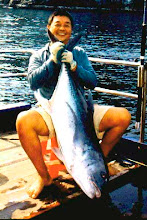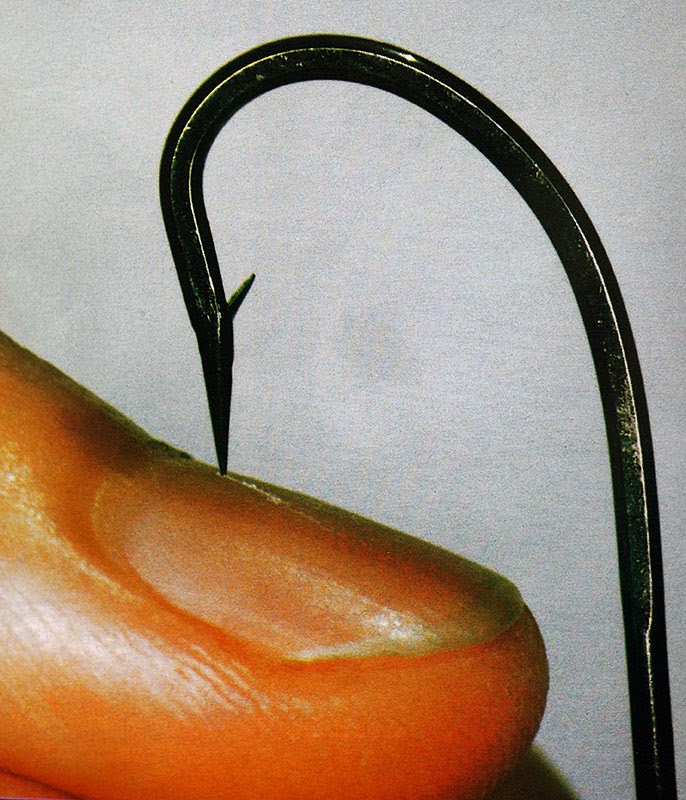 |
| This article was published in the February 2002 issue of Rod And Line magazine. |
"Fish on, fish on," I screamed at the top of my voice. Being alone at the back of the boat, I had no choice but to scream. With the diesel engine droning away, it was a wonder anyone could hear me. Somehow I was heard and the boat slowed to a stop. With half a spool of mono gone, it was a long and tedious pump and wind affair with my TLD 25 single speed. When the torpedo shaped silhouette jumped, the whole gang chorused, tenggiri". I eased off on the drag when the unmistakable stripes of the mackerel could be seen. As expected, the fish made one final lunge and my empty hook cum skirt came flying back.
 |
| The gang posing proudly with James's sailfish. |
After one year of planning, we finally got everything to click together for this trip. Phang asked us to join this trip organised by Khong. As we planned only for GTs and sailfish, the six of us got hold of the 'Top Gun II". A bit smaller than the usual boats that we were used to, it was still safe and quite comfortable.
The first thing that we noticed was the crystal clear water of Jarak. Casting our lures as the boat slowly chucked around the island, we were in high spirit. Khong's red popper was the first to be attacked. The small trevally gave him a good run for his money. Phang, casting from the roof of the boat was the next to land another. He must have a very good martial master, as he never lost his balance even though the boat was rocking wildly from side to side. We were using mostly poppers and the evergreen Abu Kosters. When we called it a day, Khong had three trevallies while Phang had one. James, the Ng brothers (Kar Loon and Chee Seng) and I were empty handed although we had a few strikes.
 |
| Khong displaying his trevally taken with a popper. |
Popping for GTs is always a hectic affair. We normally cast our lures towards the island, crank like crazy and try to impart as much life as possible to the lures. With the boat rocking like a roller coaster, it was rather a taxing on even fit young anglers. If a trevally is hooked, it will head straight for the high reefs and rocky outcrops to cut you off. Its tail too can be used as a line cutter. Being flat bodied, they can really exert a lot of force on your arms, legs and back muscles.
 |
| Me and my sailfish with Khong holding up the fin. |
When night fell a few of us were doing bottom fishing. Yours truly being a bit over the hills decided to conserve energy for the next day. Suddenly, shouts were heard and Kar Loon was seen fighting with a whopper. The 6kg ray was brought up after a seesaw battle. Chee Seng was next to have a fight on his hand. That barracuda really made his trip worthwhile, as he was only fifteen.
 |
| Phang caught one from the roof too. |
The moment the sun's ray cast their lighted shafts across the sea, we upped anchor. Casts after casts were made but none of us got any strikes. All in we made almost ten passes round Jarak without any positive result. It was then decided that we stop for breakfast. Two lines were drifted out with kembong as baits.
 |
| These blisters were a result of the crazy casting and reeling during our spinning sessions. |
Although sails were seen cruising nearby and some were jumping in the distance there were no hookups.
With renewed energy from our breakfast, we decided to continue casting. I let out my skirt to troll after we decided to try one more method for a change. That was when I lost my tengirri. Feeling disappointed but not defeated, I let out my skirt again as soon as I have checked the leader for damage. Almost immediately after I had set my reel, its alarm went off again. Thinking I had hooked up some debris, I was in no hurry to grab the rod. When the dark shape of a sail came shooting out of the water in the distance, I immediately moved into top gear.
Attracted by all my shouting and screaming( this old goat still has two powerful lungs) everyone seemed to appear from nowhere. The deck was cleared and a 'fighting chair' was put at my disposal. Phang quickly hooked on a butt cap for me and I settled down to the battle. The sails fought, ran and tail walked for almost 20 minutes before it was finally grabbed on the bill by James. With Kar Loon holding on to the tail it was gently hauled on to the deck. We took our remembrance photos, revived and released it in record time of only three minutes. None the worst from its encounter except for a sore mouth and wounded pride, my sail banked away to freedom with a swipe of its tail.
 |
| The fish slowly giving up. Note the red skirt near its mouth. |
By now everyone seemed in the mood to troll. Three lines were let out. James used a store-bought moulded head with skirt. Khong was using a bibless, while Kar Loon was using a self-made hexagonal chrome head with skirt.
 |
| Kar Loon trying to grab James's tail-wrapped sails. |
As the saying goes "when it rain it pours". James' skirt was attacked and the reel screamed it protest. He was agile for his size. Plopping himself on to the chair he was pumping and cranking like crazy. Beads of sweat could be seen dripping down his grim and determined face. The athmostphere was sizzling with tension. Phang was filming the whole fight with his video cam while I was taking stills. Being next to the cabin, I was giving instruction to Ah Hock on the direction to steer the boat so as to allow James a clear area to fight the sail.
 |
| The Ng brothers, Kar Loon with his ray and Chee Seng with his barracuda. |
At one point James and the sail were stalemated with my chubby friend panting away. Phang was whispering to me, "Fei Loh finished loh". I didn't realised I was screaming to James when I told him not to allow the sail to rest. Suddenly James announced that the fish had died. When the "dead" fish was brought near the boat we realised that it was tail-wrapped. Kar Loon grabbed its bill. With Khong and Chee Seng at the tail end, it was tenderly lifted up. Our group photographs were taken and the fish revived by dragging it along with the moving boat. When it started to struggle, it was released to fight another day.
 |
| The taikong of "To Gun II", Mr Lee Theam Hock. |
This sail was lucky as it was hooked just about two centimeters from its eyes. The next lure to be hit was Khong's bibless. The alarm sounded for a few seconds and then there was silence. When it was reeled back the treble was found to have opened up. My skirt, used by Kar Loon, was grabbed and the alarm sounded its adrenaline releasing music for a short while. When the limp line was reeled back the leader was found to have been broken.
 |
| My revived sails being released. |
Our success was a combination of the close and unselfish cooperation between the seven of us. When a fish was on, everyone chipped in to do his bit thus resulting in the landing of my 40kg and James 50kg sails. I doubt, in the case of hard running and fighting bill fish, success could be had without the helping and sharing attitude of everyone on board. Luckily for us too that the taikong was willing to follow our instructions in steering the boat to facilitate the fighting of the sails.











































